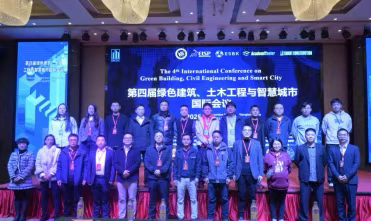由湖南工程学院主办,湖南工程学院智慧建造与能源工程学院承办,并获得了爱迩思出版社(ELSP)、ESBK国际学术交流中心、AC学术平台、《Smart Construction》期刊、北京工业大学、中南大学、桂林理工大学、湘潭大学、湖南大学、昆明理工大学、湖南科技大学、湖南工业大学、西南林业大学、吉林建筑大学、湖南理工学院、湖南城市学院、河南省生态建筑与环境构建工程研究中心协办等多个单位联合支持的第四届绿色建筑、土木工程与智慧城市国际会议(GBCESC 2025),于2025年12月6日在湖南湘潭圆满落幕。本次会议汇聚了多个地区的专家学者,围绕绿色建筑、土木工程与智慧城市等前沿热点展开了深入交流与探讨。

大会现场合照
12月6日上午,湖南工程学院副校长丁选明教授进行开幕致辞。他代表主办单位向参会的专家和来宾表示热烈欢迎,对支持单位表示感谢,丁教授真诚希望各位专家把先进理念、技术带到湖南、带到湘潭,带领湖南共攀绿色、智慧科技高峰。

湖南工程学院副校长丁选明教授作开幕致辞
随后,桂林理工大学副校长钱凯教授进行了欢迎致辞。钱教授表示GBCESC系列会议始终致力于搭建一个高水平的国际学术交流平台,并希望各位与会者能够充分展示智慧、激荡思想、凝聚共识,不仅探讨技术创新,也关注政策导向、标准建设与商业模式,共同为推动全球城市与建筑行业的绿色化、数字化、智能化转型贡献真知灼见。

桂林理工大学副校长钱凯教授作欢迎致辞
本次大会汇聚了高水平行业专家和学者,我们非常荣幸地邀请到了多位在各自领域享有盛誉的国际知名专家:日本工程院外籍院士-北京工业大学赵衍刚教授,国家优青北京工业大学金浏教授,北京工业大学科发院副院长刘占省教授,国家级人才计划-武汉大学赵福云教授,长江学者-浙江大学梅国雄教授(线上),国家级高层次青年人才-湖南大学丁政豪教授,他们带来了精彩的主旨报告,为大会增添了浓墨重彩的一笔。

▲日本工程院外籍院士-北京工业大学赵衍刚教授作主旨报告

▲国家优青-北京工业大学金浏教授作主旨报告

▲北京工业大学科发院副院长刘占省教授作主旨报告

▲国家级人才计划-武汉大学赵福云教授作主旨报告

▲国家级高层次青年人才-湖南大学丁政豪教授作主旨报告
下午,会议开设了院长论坛,与会专家围绕两大主题达成重要共识:面对“绿色与智能”的双重驱动,土木工程学科的边界正在发生本质性拓展,与新一代信息技术、材料科学及环境科学的交叉融合已成为学科发展的必然趋势。这一变革对人才培养提出了新的要求。
在此背景下,以工程教育专业认证标准为指导,系统推进课程体系重构势在必行。核心在于使课程设置和培养目标与学科新发展及行业新需求紧密对接,确保人才培养质量满足未来工程实践的需要。该论坛形成的共识为学科的战略转型与教学改革提供了明确方向。


院长论坛现场
吉林建筑大学在吉林也盛大召开了第二会场,在吉林会场以及湘潭下午的分论坛环节中,来自多所高校和科研单位的学者分享了自己的最新研究进展。这些报告的发言,有见解,有特色,大家解放思想、畅所欲言,激荡出思想碰撞的火花,使会议充满了浓厚的研讨氛围。

▲吉林建筑大学第二会场合照

▲分论坛一合照

▲分论坛二合照

▲分论坛三合照

▲分论坛四合照
大会举行了晚宴暨颁奖仪式,对会议支持单位以及在会议投稿、论坛组织及报告学者中表现突出的组织和个人进行了表彰。在温馨的氛围中,与会者们借此机会互相交流,增进了彼此的了解和合作。随着晚宴的结束,第四届绿色建筑、土木工程与智慧城市国际会议也圆满落幕。



图组 颁奖晚宴
第四届绿色建筑、土木工程与智慧城市国际会议(GBCESC 2025)的成功举办,不仅为学术界和产业界搭建了一个思想碰撞、成果共享的平台,更进一步促进了相关领域的跨界融合与协同创新。主办方表示,相信在各方的持续努力与支持下,GBCESC将不断汇聚智慧与力量,打破学科壁垒、突破技术瓶颈,快速转化为推动产业升级推动科技进步与产业发展,共同开启智能时代的新篇章。